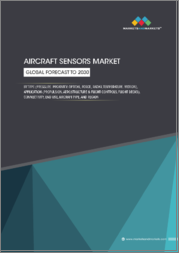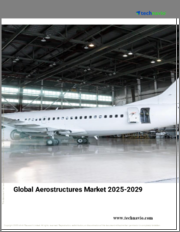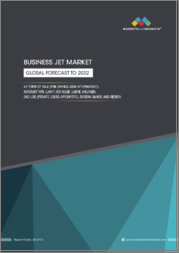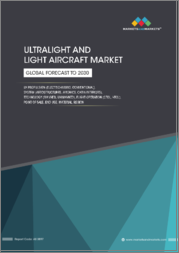
|
시장보고서
상품코드
1752826
세계의 항공 구조물 시장 : 구성요소별, 재료별, 플랫폼별, 지역별, 기회 및 예측(2018-2032년)Global Aerostructures Market Assessment, By Component, By Material, By Platform, By Region, Opportunities and Forecast, 2018-2032F |
||||||
세계 항공 구조물 시장은 2025-2032년 예측 기간 동안 6.12%의 CAGR을 기록하며 2024년 686억 7,000만 달러에서 2032년 1,104억 4,000만 달러로 성장할 것으로 예상됩니다. 항공 구조물 시장은 항공기 현대화, 경량화, 첨단 제조 공정으로 인해 성장하고 있습니다. 복합재료, 재사용 가능한 재료, 3D 프린팅, 자동화 공정의 새로운 발전은 효율성, 내구성, 지속가능성을 향상시키고 산업을 변화시키고 있습니다. 항공기의 수요와 규제 요건으로 인해 연비 효율적인 설계와 친환경 소재의 사용이 강조되고 있습니다. 고정익 및 회전익 항공기 시장은 OEM이 기존의 선행 비용에서 보다 비용 효율적인 생산 및 설계 최적화로 전환함에 따라 확대되고 있습니다. 항공우주 기술은 많은 분야에서 발전하고 있으며, 차세대 항공 구조물는 성능 향상, 배기가스 배출 최소화, 일부 장점의 장기적인 보장을 통해 업계 추세를 계속 주도할 것으로 보입니다.
예를 들어, 2025년 4월에는 Airbus H130 헬리콥터 동체가 Mahindra Group(Mahindra Aerostructures)에 의해 제작되어 2027년 3월까지 첫 번째 유닛이 인도에 인도될 예정이며, 이는 인도의 국산 항공우주 제조 활동에 큰 탄력을 줄 것입니다. 큰 탄력을 받게 될 것입니다.
목차
제1장 프로젝트 범위와 정의
제2장 조사 방법
제3장 미국 관세의 영향
제4장 주요 요약
제5장 고객의 소리
- 응답자 인구통계
- 브랜드 인지도
- 구입 결정시에 고려되는 요소
- 전투준비와 상호운용성
- 운영 비용과 연비
제6장 세계의 항공 구조물 시장 전망, 2018-2032년
- 시장 규모 분석과 예측
- 금액별
- 시장 점유율 분석과 예측
- 구성요소별
- 날개
- 기체
- 나셀·파일론
- 미익
- 재료별
- 복합재료
- 합금·초합금
- 금속
- 기타
- 플랫폼별
- 상용기
- 군용기
- AAM
- 지역별
- 북미
- 유럽
- 아시아태평양
- 남미
- 중동 및 아프리카
- 기업별 시장 점유율 분석(상위 5개사·기타 - 금액별, 2024년)
- 구성요소별
- 2024년 시장 맵 분석
- 구성요소별
- 재료별
- 플랫폼별
- 지역별
제7장 북미의 항공 구조물 시장 전망, 2018-2032년
- 시장 규모 분석과 예측
- 금액별
- 시장 점유율 분석과 예측
- 구성요소별
- 날개
- 기체
- 나셀·파일론
- 미익
- 재료별
- 복합재료
- 합금·초합금
- 금속
- 기타
- 플랫폼별
- 상용기
- 군용기
- AAM
- 국가별 점유율
- 미국
- 캐나다
- 멕시코
- 구성요소별
- 국가별 시장 평가
- 미국의 항공 구조물 시장 전망, 2018-2032년
- 시장 규모 분석과 예측
- 시장 점유율 분석과 예측
- 캐나다
- 멕시코
- 미국의 항공 구조물 시장 전망, 2018-2032년
제8장 유럽의 항공 구조물 시장 전망, 2018-2032년
- 독일
- 프랑스
- 이탈리아
- 영국
- 러시아
- 네덜란드
- 스페인
- 튀르키예
- 폴란드
제9장 아시아태평양의 항공 구조물 시장 전망, 2018-2032년
- 인도
- 중국
- 일본
- 호주
- 베트남
- 한국
- 인도네시아
- 필리핀
제10장 남미의 항공 구조물 시장 전망, 2018-2032년
- 브라질
- 아르헨티나
제11장 중동 및 아프리카의 항공 구조물 시장 전망, 2018-2032년
- 사우디아라비아
- 아랍에미리트
- 남아프리카공화국
제12장 Porter's Five Forces 분석
제13장 PESTLE 분석
제14장 시장 역학
- 시장 성장 촉진요인
- 시장 과제
제15장 시장 동향과 발전
제16장 사례 연구
제17장 경쟁 구도
- 시장 리더 상위 5개사 경쟁 매트릭스
- 상위 5개사 SWOT 분석
- 상위 10개사의 주요 기업 상황
- GKN plc
- Leonardo SpA
- Elbit Systems Ltd.
- Cyient Limited
- Triumph Group, Inc.
- Spirit AeroSystems Inc.
- Saab Group
- Bombardier Inc.
- The Boeing Company
제18장 전략적 제안
제19장 조사 회사 소개 및 면책사항
ksm 25.06.27Global aerostructures market is projected to witness a CAGR of 6.12% during the forecast period 2025-2032, growing from USD 68.67 billion in 2024 to USD 110.44 billion in 2032. The aerostructures market is growing because of fleet modernization, lightweight materials, and advanced manufacturing processes. New advancements in composites and reusable materials, 3D printing, and automated processes increase efficiencies, durability, and sustainability, leading the industry toward transformation. Demand for air travel and regulatory requirements are driving emphasis on fuel-efficient designs and the use of eco-friendly materials. The market for fixed-wing and rotary-wing aircraft is growing as OEMs transition from traditional, upfront costs to more cost-effective production and design optimization. Aerospace technology is advancing in many areas, and the next generation of aerostructures will continue to drive the trends of the industry by improving performance, minimizing emissions and assuring that some benefits are long-term.
For instance, in April 2025, the fuselage of the single-engine Airbus H130 helicopters will be manufactured by Mahindra Group (Mahindra Aerostructures), with the first unit expected to be delivered by March 2027, thus giving a big boost to indigenous aerospace manufacturing activities in India.
Competitive Landscape and Strategic Positioning Enhance Market Growth
The expansion of the aerostructure sector reaches the limits of manufacturing. The competitive conditions and strategic positioning allow manufacturers the opportunity to enhance sustainability, durability, and efficiency. Organizations in this sector are targeting efforts towards automation, light-weight components, and advanced manufacturing processes to maximize output and position themselves as leaders in their respective fields. Organizations utilize partnerships, acquisitions, and [investment in] technology and innovation to establish their position in a growing marketplace. Aerospace marvels of the next generation, which ensure fuel savings, regulatory compliance, and ultimately lower [operational costs], continue to shape industry growth and development as aerospace technology continues to evolve.
For instance, in July 2024, General Electric Company (GE Aerospace) has signed a Memorandum of Understanding (MOU) with Turkish Aerospace and TUSAS Engine Industries Inc. (TEI) to evaluate and collaborate on integrating GE Aerospace's F404 engine into new HURJET aircraft variants, an extension of the companies' current relationship on the HURJET program.
Strategic Industry Collaborations Fuel Market Expansion
The growing development of the aerostructures market is majorly aided by strategic industry alliances that give manufacturers opportunities to work on efficiency and sustainability and to adopt new technologies. In enhancing their production processes, development of materials, use of resources, and price competitiveness, manufacturers are entering cooperative partnerships and joint-venture agreements as well as technology-sharing contracts, regardless of their primary role in the product value chain. As the aerospace sector continues to thrive through technological advancement from one sector to another, such partnerships will influence the growth of the aerostructures market and sustain jobs and growth in the aerospace sector. Manufacturers can advance digital technology, sustainability strategies, and operational efficiency by pooling available intellectual and physical resources through partnerships. The future of the aerostructures market is collaborative innovation, equipped to offer optimal price capabilities and innovative aerostructure solutions.
For instance, in May 2025, Vertical Aerospace and Honeywell International, Inc. entered into a new long-term agreement that further strengthens their partnership and assumes a greater commitment on Honeywell's part regarding the certification and production of Vertical's eVTOL VX4.
Wing Structures Driving Aerostructures Market Growth
Wing structures drive growth in the aerostructures market as lightweight materials, aerodynamic efficiency, and fuel efficiency continue to improve. The evolution of aircraft designs is shifting from traditional wing designs to composite wings and high-lift configurations with integrated control surfaces to enhance performance. This sets the stage for deploying and innovating next-generation technologies for wings and wing designs, such as morphing wings and active flow control. As air traffic levels increase and sustainability initiatives emerge, wing-related advances keep the market moving forward and help aircraft design manufacturers set themselves apart from the competition.
For instance, in March 2025, RTX Corporation announced that it had signed three agreements with JetZero to supply key systems for the company's full-scale blended wing body (BWB) aircraft demonstrator. Under the agreements, RTX Corporation (Collins Aerospace) will provide propulsion and structural components.
North America Dominates the Aerostructures Market
The market for aerostructures is on a considerable upswing, with the expansion of fleets, lighter materials, and newer manufacturing techniques. Innovations in composite materials, additive manufacturing, 3D printing, and the use of automation in design not only allow for "green" aerostructures and lead to more efficient, robust, and sustainable efficiencies within structures. Manufacturers' efforts to meet the rising demand for air travel and comply with regulations compel OEMs to produce fuel-efficient designs using appropriate manufacturing facilities and use eco-friendly materials. The market is growing both in fixed-wing and rotary-wing aircraft, where cost-effective production and optimized structural configurations provide opportunities to generate maximum value from investments in the new structures. Given the evolution of aerospace technology, the trends seen in the next gen aerostructures will continue, generating additional value based on extended performance, reduced emissions, and long-term operational benefits.
For instance, in December 2024, RTX Corporation signed a memorandum of understanding (MOU) with the Netherlands Aerospace Group (NAG), providing a strategic framework for collaboration on technology research and development. Under the MOU, Collins Aerospace will collaborate with Dutch aerospace companies and research institutions across the Netherlands to develop advanced technologies for sustainable aviation.
Impact of U.S. Tariffs on Global Aerostructures Market
Costs Increasing: Tariffs on steel, aluminum, and aerospace components have increased our production costs.
Supply Chain Disruptions: Restrictions on the continued importation of materials create restrictions on production and delays in distribution.
Market Competition Problems: U.S. manufacturers are struggling to be competitive with the escalating global cost of manufacturing and the increased costs of materials.
Stifling Innovation: Tariffs on advanced composites and automation technologies will stifle innovation in our industry.
Key Players Landscape and Outlook
Key players in the aerostructures industry are concentrating on automation, sustainability, and advanced materials to increase durability and efficiency. To maximize output and satisfy changing aerospace needs, industry leaders make investments in 3D printing, AI-driven manufacturing, and lightweight composites. Fleet expansion, legal requirements, and technological breakthroughs drive the market's positive outlook. To ensure economical and dependable aircraft performance, innovations in fuel-efficient designs, modular aerostructures, and smart monitoring systems continue to influence industry trends.
For instance, in September 2023, Saab Group and The Boeing Company extended their partnership for the 787 Dreamliner program, reinforcing their collaboration on cargo door manufacturing. Saab has already supplied over 1,100 shipsets, showcasing its expertise in aerostructures for both military and commercial aircraft. The newly extended contract ensures continued innovation in composite materials and lightweight door systems.
Table of Contents
1. Project Scope and Definitions
2. Research Methodology
3. Impact of U.S. Tariffs
4. Executive Summary
5. Voice of Customers
- 5.1. Respondent Demographics
- 5.2. Brand Awareness
- 5.3. Factors Considered in Purchase Decisions
- 5.4. Combat Readiness and Interoperability
- 5.5. Operational Costs and Fuel Efficiency
6. Global Aerostructures Market Outlook, 2018-2032F
- 6.1. Market Size Analysis & Forecast
- 6.1.1. By Value
- 6.2. Market Share Analysis & Forecast
- 6.2.1. By Component
- 6.2.1.1. Wings
- 6.2.1.2. Fuselage
- 6.2.1.3. Nacelles and Pylons
- 6.2.1.4. Empennage
- 6.2.2. By Material
- 6.2.2.1. Composites
- 6.2.2.2. Alloys and Superalloy
- 6.2.2.3. Metals
- 6.2.2.4. Others
- 6.2.3. By Platform
- 6.2.3.1. Commercial Aircraft
- 6.2.3.2. Military Aircraft
- 6.2.3.3. Advanced Air Mobility
- 6.2.4. By Region
- 6.2.4.1. North America
- 6.2.4.2. Europe
- 6.2.4.3. Asia-Pacific
- 6.2.4.4. South America
- 6.2.4.5. Middle East and Africa
- 6.2.5. By Company Market Share Analysis (Top 5 Companies and Others - By Value, 2024)
- 6.2.1. By Component
- 6.3. Market Map Analysis, 2024
- 6.3.1. By Component
- 6.3.2. By Material
- 6.3.3. By Platform
- 6.3.4. By Region
7. North America Aerostructures Market Outlook, 2018-2032F
- 7.1. Market Size Analysis & Forecast
- 7.1.1. By Value
- 7.2. Market Share Analysis & Forecast
- 7.2.1. By Component
- 7.2.1.1. Wings
- 7.2.1.2. Fuselage
- 7.2.1.3. Nacelles and Pylons
- 7.2.1.4. Empennage
- 7.2.2. By Material
- 7.2.2.1. Composites
- 7.2.2.2. Alloys and Superalloy
- 7.2.2.3. Metals
- 7.2.2.4. Others
- 7.2.3. By Platform
- 7.2.3.1. Commercial Aircraft
- 7.2.3.2. Military Aircraft
- 7.2.3.3. Advanced Air Mobility
- 7.2.4. By Country Share
- 7.2.4.1. United States
- 7.2.4.2. Canada
- 7.2.4.3. Mexico
- 7.2.1. By Component
- 7.3. Country Market Assessment
- 7.3.1. United States Aerostructures Market Outlook, 2018-2032F*
- 7.3.1.1. Market Size Analysis & Forecast
- 7.3.1.1.1. By Value
- 7.3.1.2. Market Share Analysis & Forecast
- 7.3.1.2.1. By Component
- 7.3.1.2.1.1. Wings
- 7.3.1.2.1.2. Fuselage
- 7.3.1.2.1.3. Nacelles and Pylons
- 7.3.1.2.1.4. Empennage
- 7.3.1.2.2. By Material
- 7.3.1.2.2.1. Composites
- 7.3.1.2.2.2. Alloys and Superalloy
- 7.3.1.2.2.3. Metals
- 7.3.1.2.2.4. Others
- 7.3.1.2.3. By Platform
- 7.3.1.2.3.1. Commercial Aircraft
- 7.3.1.2.3.2. Military Aircraft
- 7.3.1.2.3.3. Advanced Air Mobility
- 7.3.1.2.1. By Component
- 7.3.1.1. Market Size Analysis & Forecast
- 7.3.2. Canada
- 7.3.3. Mexico
- 7.3.1. United States Aerostructures Market Outlook, 2018-2032F*
All segments will be provided for all regions and countries covered
8. Europe Aerostructures Market Outlook, 2018-2032F
- 8.1. Germany
- 8.2. France
- 8.3. Italy
- 8.4. United Kingdom
- 8.5. Russia
- 8.6. Netherlands
- 8.7. Spain
- 8.8. Turkey
- 8.9. Poland
9. Asia-Pacific Aerostructures Market Outlook, 2018-2032F
- 9.1. India
- 9.2. China
- 9.3. Japan
- 9.4. Australia
- 9.5. Vietnam
- 9.6. South Korea
- 9.7. Indonesia
- 9.8. Philippines
10. South America Aerostructures Market Outlook, 2018-2032F
- 10.1. Brazil
- 10.2. Argentina
11. Middle East and Africa Aerostructures Market Outlook, 2018-2032F
- 11.1. Saudi Arabia
- 11.2. UAE
- 11.3. South Africa
12. Porter's Five Forces Analysis
13. PESTLE Analysis
14. Market Dynamics
- 14.1. Market Drivers
- 14.2. Market Challenges
15. Market Trends and Developments
16. Case Studies
17. Competitive Landscape
- 17.1. Competition Matrix of Top 5 Market Leaders
- 17.2. SWOT Analysis for Top 5 Players
- 17.3. Key Players Landscape for Top 10 Market Players
- 17.3.1. Airbus SE
- 17.3.1.1. Company Details
- 17.3.1.2. Key Management Personnel
- 17.3.1.3. Key Products Offered
- 17.3.1.4. Key Financials (As Reported)
- 17.3.1.5. Key Market Focus and Geographical Presence
- 17.3.1.6. Recent Developments/Collaborations/Partnerships/Mergers and Acquisition
- 17.3.2. GKN plc
- 17.3.3. Leonardo S.p.A.
- 17.3.4. Elbit Systems Ltd.
- 17.3.5. Cyient Limited
- 17.3.6. Triumph Group, Inc.
- 17.3.7. Spirit AeroSystems Inc.
- 17.3.8. Saab Group
- 17.3.9. Bombardier Inc.
- 17.3.10. The Boeing Company
- 17.3.1. Airbus SE
Companies mentioned above DO NOT hold any order as per market share and can be changed as per information available during research work.



















